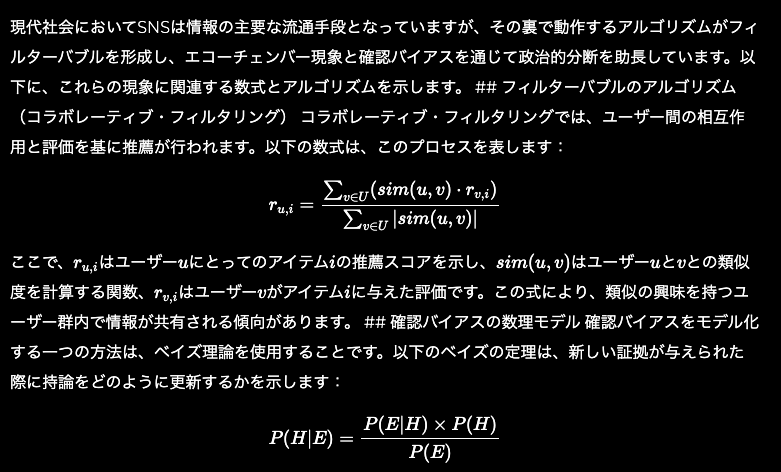In today’s society, social media serves as a primary conduit for information, yet the algorithms behind it foster filter bubbles, which in turn promote echo chambers and confirmation bias, exacerbating political divisions. Below are the mathematical formulas and algorithms related to these phenomena. ## Collaborative Filtering Algorithm Collaborative filtering involves recommendations based on user interactions and evaluations. The following formula represents this process: \[ r_{u,i} = \frac{\sum_{v \in U}(sim(u, v) \cdot r_{v,i})}{\sum_{v \in U}|sim(u, v)|} \] Here, \( r_{u,i} \) represents the recommendation score for user \( u \) regarding item \( i \), \( sim(u, v) \) is the function calculating the similarity between users \( u \) and \( v \), and \( r_{v,i} \) is the rating given by user \( v \) to item \( i \). ## Mathematical Model of Confirmation Bias One way to model confirmation bias is through Bayesian theory. The following Bayes’ theorem illustrates how opinions are updated upon receiving new evidence: \[ P(H|E) = \frac{P(E|H) \times P(H)}{P(E)} \] In this formula, \( H \) represents the hypothesis, \( E \) represents new evidence, and \( P(H|E) \) is the probability of the hypothesis \( H \) given the evidence \( E \). ## Impact of Algorithmic Bias in Information Social media algorithms are designed to maximize user engagement, often promoting content that elicits emotional responses or polarizing views. The bias in information can be represented by the following simple probability model: \[ P(i) = \frac{e^{\beta \cdot x_i}}{\sum_j e^{\beta \cdot x_j}} \] Here, \( x_i \) represents the characteristics associated with content \( i \) (e.g., engagement, emotional reactions), and \( \beta \) adjusts the impact of these characteristics.
The Echo Chambers of Social Media: A Mathematical Approach to Political Polarization Through Filter Bubbles and Confirmation Bias
20
previous post

